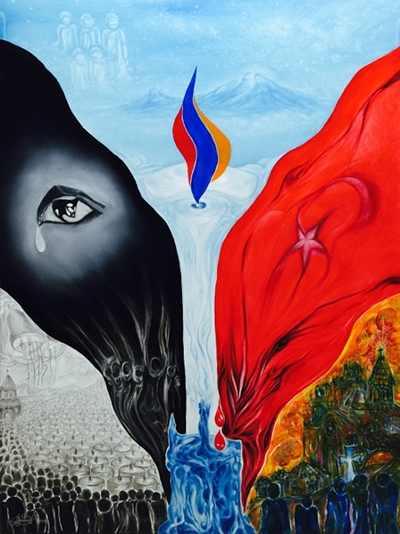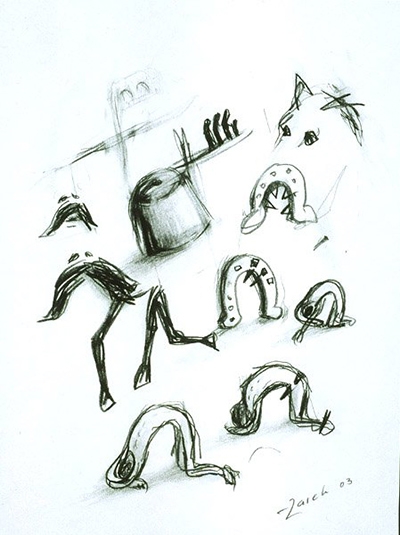CULTURAL GENOCIDE

Acts and measures undertaken to destroy the culture of a nation or an ethnic group is called "cultural genocide". Many facts prove that simultaneous with the massacres and deportation of Armenians in the Ottoman Empire, the government of the Young Turks masterminded and implemented systematic destruction of the material testimonies of the Armenian civilization.
THE ARMENIAN GENOCIDE

A genocide is the organized extermination of a nation aiming to put an end to their collective existence. The extermination of Armenians in the Ottoman Empire and the surrounding regions during 1915-1923 is called the Armenian Genocide. Those massacres were masterminded and perpetrated by the government of Young Turks and were later finalized by the Kemalist government.
view more
The anguish of the Armenian Genocide, which is being reborn with every Armenian, has its own reflection in the Armenian fine arts. Many Armenian well known artists have created artworks both in Armenia and in Diaspora that are the speaking witness of the Armenian great pain, loss and yearning. These artworks are also ode to the Armenian viable genes, will power of giving birth, living and creation. Genocide is the type of crime that does have any expiration date. Human speech is sometimes powerless in expressing those things that are possible to express only through art. These 100 artworks will continuously tell the world about the unhealed wound of the Armenian, millions of innocent victims, demolished heartlands, bowed churches, lost homeland and infinite belief. The power of art is undeniable and artworks are eternal.
Artist:
Sergei Parajanov
Title:
Golgotha, 1979
Location:
Sergei Parajanov Museum, Yerevan

Artist: Sergei Parajanov
Title: Golgotha, 1979
Location: Sergei Parajanov Museum, Yerevan
Sergey Parajanov usually doesn't comment on his works so as each viewer could feel and describe the art on their own way. This work belongs to the series of non-described works of the master as well.
Artist:
Krikor Momdjian
Title:
The Missing Poet, 2009
Location:
Artist's Collection

Artist: Krikor Momdjian
Title: The Missing Poet, 2009
Location: Artist's Collection
Krikor Momdjian: "This painting is to remember the missing poets who were arrested on the night of April 24th in 1915 in Constantinople and put to death, around 2500 Armenian intellectuals. The nature is revolting in anger. You can smell the blood in the dirty water explosion. They will never be forgotten, on the contrary, their memory has been cherished almost everyday for the past hundred years. I hope their souls will come to rest when justice is achieved by recognition and conciliation."
Artist:
Sarkis Mooradyan
Title:
Komitas. Last Night, 1956
Location:
National Gallery of Armenian, Yerevan

Artist: Sarkis Mooradyan
Title: Komitas. Last Night, 1956
Location: National Gallery of Armenian, Yerevan
The Armenian composer, singer, ethno musician, musicologist, archimandrite and teacher Komitas suffered a lot seeing the anguish of the Armenian nation. This characters is stamped as the symbol of the Armenian Genocide and many Armenian artists emphasized that symbol painting Komitas. Sarkis Muradyan’s Komitas dressed in red, the color of blood and the entrance of the Turkish officers with swords symbolize the upcoming bloody crime.
Artist:
Eduard Isabekyan
Title:
Western Armenia, 1940
Location:
Artist's Family Collection

Artist: Eduard Isabekyan
Title: Western Armenia, 1940
Location: Artist's Family Collection
Eduard Isabekyan: "Memory is a very important thing. There is no other nation in the world that needs memory more than the Armenian nation. Because there is no other nation in the world that has left its property, its soil, 99% of everything owned to others. If Igdirtsis forget Igdir, Alashkertsis - Alashker, Vanetsis forget Van, Bayazettsis - Bayazets and etc If they forget that the entire nation never forgot where they are from. The Armenian needs our memory, for him to be able to own whatever his has lost, so as always to remember that he has to bring back whatever he has lost."
view more
share your arts
Here, you can upload your artwork dedicated to the Armenian Genocide. The uploaded artwork will be published in the
SHARED ARTS section.
Note: the site carries no responsibility over the copyright genuinity issues in the SHARED ARTS section. But still if you come across possible violation of copyrights, please, do not hesitate to contact us via info@100years100arts.am email address.

Artist: Adriana Angolian
Live Memory, 1994

Artist: Adriana Angolian
Gold Universe, 2016
Artist:
Khoren Der Harootian

Artist: Khoren Der Harootian
Ani (bronze), 1963
Artist:
Alexander Sadoyan

Artist: Alexander Sadoyan
Immigration
Artist:
Alexander Sadoyan

Artist: Alexander Sadoyan
Untitled

Artist: Levon Fljyan
Our Ancestors-2 (from Pixel 2 project), 2012

Artist: Kaloust Guedel
All Men are Created Alike, 2003

Artist: Zareh
Turkish Soup Made with Armenian Bones, 1998

Artist: Arthur Lazaryan
Never Again
view more



























